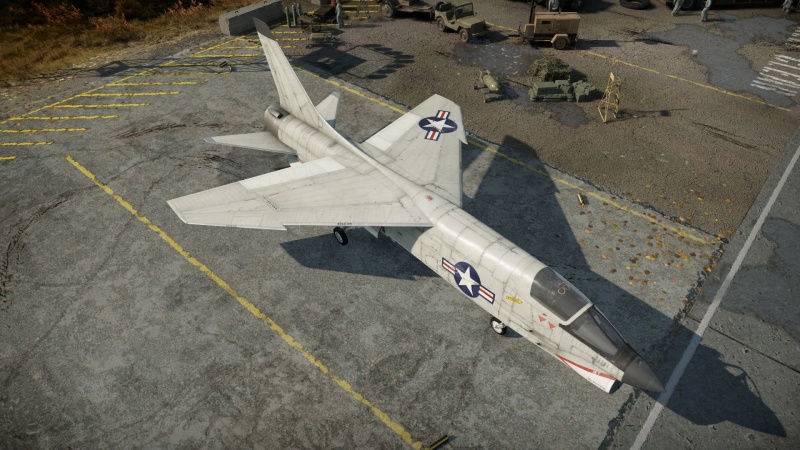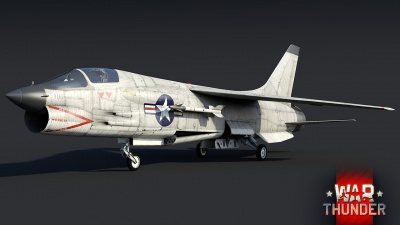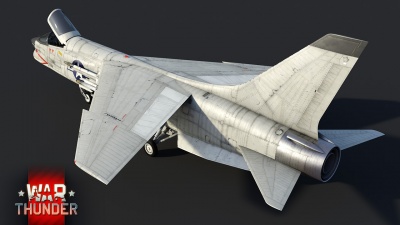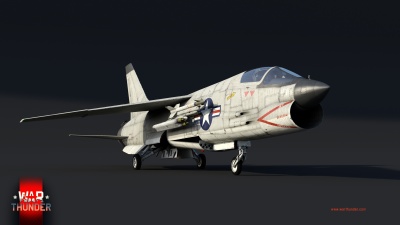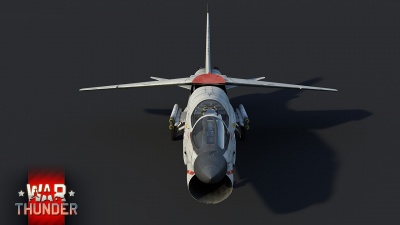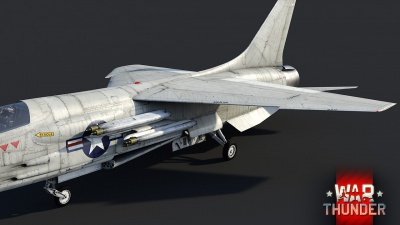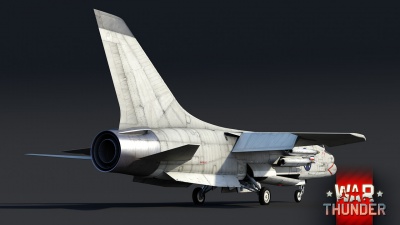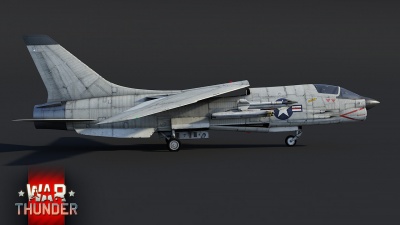Difference between revisions of "F8U-2"
(→Media: Added skins) |
(→History) (Tag: Visual edit) |
||
| Line 196: | Line 196: | ||
== History == | == History == | ||
<!-- ''Describe the history of the creation and combat usage of the aircraft in more detail than in the introduction. If the historical reference turns out to be too long, take it to a separate article, taking a link to the article about the vehicle and adding a block "/History" (example: <nowiki>https://wiki.warthunder.com/(Vehicle-name)/History</nowiki>) and add a link to it here using the <code>main</code> template. Be sure to reference text and sources by using <code><nowiki><ref></ref></nowiki></code>, as well as adding them at the end of the article with <code><nowiki><references /></nowiki></code>. This section may also include the vehicle's dev blog entry (if applicable) and the in-game encyclopedia description (under <code><nowiki>=== In-game description ===</nowiki></code>, also if applicable).'' --> | <!-- ''Describe the history of the creation and combat usage of the aircraft in more detail than in the introduction. If the historical reference turns out to be too long, take it to a separate article, taking a link to the article about the vehicle and adding a block "/History" (example: <nowiki>https://wiki.warthunder.com/(Vehicle-name)/History</nowiki>) and add a link to it here using the <code>main</code> template. Be sure to reference text and sources by using <code><nowiki><ref></ref></nowiki></code>, as well as adding them at the end of the article with <code><nowiki><references /></nowiki></code>. This section may also include the vehicle's dev blog entry (if applicable) and the in-game encyclopedia description (under <code><nowiki>=== In-game description ===</nowiki></code>, also if applicable).'' --> | ||
| + | The '''F8U-2 Crusader''' was a version of the F8U Crusader that was improved from the F8U-1 in a few ways, resulting from the advent of a new P&W engine. | ||
| + | |||
| + | The largest improvement was in the addition of the Pratt and Whitney J57-P-16 engine that was rated to produce 16,900 lbf of thrust. The new engine resulted in a higher maximum speed of up to 960 knots (1777.92 kilometers per hour). Two air scoops were added to the tail cone in order to cool the more powerful (and hotter!) engine. In addition to the new engine, ventral stabilizer fins were added to the rear of the fuselage to correct stability issues. The wingspan was also reduced to 35 feet 2 inches after three inches were removed from each wingtip. A Martin-Baker F-5 ejection seat was added to the aircraft. Finally, capability to use a Y-pylon was added to carry two AIM-9 Sidewinders on each fuselage station for a total of four AIM-9 Sidewinders on the fuselage, two more than on the F8U-1. | ||
| + | |||
| + | The F8U-2 prototype was modified from the F8U-1 number four (BuNo 140477) and first flew on 20 August 1957. The F8U-2 was ordered into production and the first production F8U-2 (BuNo 145546) flew for the first time on 29 August 1958. The F8U-2 entered service in February 1959 and was redesignated as the '''F-8C Crusader''' in 1962.<ref>http://www.alternatewars.com/SAC/F-8C_Crusader_SAC_-_1_July_1967.pdf</ref><ref>https://www.vought.org/products/html/f8u-2.html</ref> | ||
| + | |||
=== [[wt:en/news/7078-development-f8u-2-crusader-the-last-of-the-gunfighters-en|Devblog]] === | === [[wt:en/news/7078-development-f8u-2-crusader-the-last-of-the-gunfighters-en|Devblog]] === | ||
In 1952, the American Naval command announced requirements for a new supersonic jet carrier-based fighter to protect carrier groups from enemy aircraft and achieve air superiority. Chance Vought Aircraft Inc., which already had considerable experience working with carrier-based aircraft, became one of the participants in the competition. Their candidate differed from the competition by a variable-incidence wing. The wing tilted upward by 5 degrees, which noticeably improved taking off and landings on short decks of aircraft carriers. | In 1952, the American Naval command announced requirements for a new supersonic jet carrier-based fighter to protect carrier groups from enemy aircraft and achieve air superiority. Chance Vought Aircraft Inc., which already had considerable experience working with carrier-based aircraft, became one of the participants in the competition. Their candidate differed from the competition by a variable-incidence wing. The wing tilted upward by 5 degrees, which noticeably improved taking off and landings on short decks of aircraft carriers. | ||
| Line 207: | Line 213: | ||
;Skins | ;Skins | ||
| + | |||
* [https://live.warthunder.com/feed/camouflages/?vehicleCountry=usa&vehicleType=aircraft&vehicleClass=jet_fighter&vehicle=f8u-2 Skins and camouflages for the {{PAGENAME}} from live.warthunder.com.] | * [https://live.warthunder.com/feed/camouflages/?vehicleCountry=usa&vehicleType=aircraft&vehicleClass=jet_fighter&vehicle=f8u-2 Skins and camouflages for the {{PAGENAME}} from live.warthunder.com.] | ||
| Line 225: | Line 232: | ||
* ''links to approximate analogues of other nations and research trees.'' --> | * ''links to approximate analogues of other nations and research trees.'' --> | ||
''Links to the articles on the War Thunder Wiki that you think will be useful for the reader, for example:'' | ''Links to the articles on the War Thunder Wiki that you think will be useful for the reader, for example:'' | ||
| + | |||
* ''reference to the series of the aircraft;'' | * ''reference to the series of the aircraft;'' | ||
* ''links to approximate analogues of other nations and research trees.'' | * ''links to approximate analogues of other nations and research trees.'' | ||
| Line 233: | Line 241: | ||
* ''other literature.'' --> | * ''other literature.'' --> | ||
''Paste links to sources and external resources, such as:'' | ''Paste links to sources and external resources, such as:'' | ||
| + | |||
* ''topic on the official game forum;'' | * ''topic on the official game forum;'' | ||
* ''other literature.'' | * ''other literature.'' | ||
| − | {{USA jet aircraft}} | + | === References === |
| + | <references />{{USA jet aircraft}} | ||
Revision as of 15:58, 30 March 2021
Contents
Description
The F8U-2 Crusader II is a rank American jet fighter with a battle rating of (AB), (RB), and (SB). It was introduced in Update "Ixwa Strike".
General info
Flight performance
| Characteristics | Max Speed (km/h at 10,668 m) |
Max altitude (metres) |
Turn time (seconds) |
Rate of climb (metres/second) |
Take-off run (metres) | |||
|---|---|---|---|---|---|---|---|---|
| AB | RB | AB | RB | AB | RB | |||
| Stock | 2,025 | 2,017 | 28.4 | 29.4 | 113.8 | 104.6 | 1,828 | |
| Upgraded | 2,054 | 2,038 | 27.6 | 28.0 | 162.5 | 137.0 | ||
Details
| Features | |||||
|---|---|---|---|---|---|
| Combat flaps | Take-off flaps | Landing flaps | Air brakes | Arrestor gear | Drogue chute |
| ✓ | X | ✓ | ✓ | ✓ | X |
| Limits | ||||||
|---|---|---|---|---|---|---|
| Wings (km/h) | Gear (km/h) | Flaps (km/h) | Max Static G | |||
| Combat | Take-off | Landing | + | - | ||
| 1555 | 1070 | N/A | 583 | ~10 | ~6 | |
| Optimal velocities (km/h) | |||
|---|---|---|---|
| Ailerons | Rudder | Elevators | Radiator |
| < 1000 | < 590 | < 500 | N/A |
Engine performance
| Engine | Aircraft mass | |||||||
|---|---|---|---|---|---|---|---|---|
| Engine name | Number | Basic Mass | Wing loading (full fuel) | |||||
| Allison J57-P-16 | 1 | 8,339 kg | 341 kg/m2 | |||||
| Engine characteristics | Mass with fuel (no weapons load) | Max Takeoff Weight | ||||||
| Weight (each) | Type | 14m fuel | 20m fuel | 30m fuel | 45m fuel | 48m fuel | ||
| 1,592 kg | Afterburning axial-flow turbojet | 9,531 kg | 9,916 kg | 10,708 kg | 11,925 kg | 12,279 kg | 12,760 kg | |
| Maximum engine thrust @ 0 m (RB / SB) | Thrust to weight ratio @ 0 m (WEP) | |||||||
| Condition | 100% | WEP | 14m fuel | 20m fuel | 30m fuel | 45m fuel | 49m fuel | MTOW |
| Stationary | 4,562 kgf | 8,003 kgf | 0.84 | 0.81 | 0.75 | 0.67 | 0.65 | 0.63 |
| Optimal | 4,804 kgf (1,000 km/h) |
8,921 kgf (1,200 km/h) |
0.94 | 0.90 | 0.83 | 0.75 | 0.73 | 0.70 |
Survivability and armour
Examine the survivability of the aircraft. Note how vulnerable the structure is and how secure the pilot is, whether the fuel tanks are armoured, etc. Describe the armour, if there is any, and also mention the vulnerability of other critical aircraft systems.
Modifications and economy
Armaments
Offensive armament
The F8U-2 is armed with:
- A choice between two presets:
- 4 x 20 mm Browning-Colt Mk12 Mod 3 cannons, nose-mounted (144 rpg = 576 total)
- 4 x 20 mm Browning-Colt Mk12 Mod 3 cannons, nose-mounted (144 rpg = 576 total) + 32 x FFAR Mighty Mouse rockets
Suspended armament
The F8U-2 can be outfitted with the following ordnance:
- Without load
- 2 x AIM-9B Sidewinder missiles
- 4 x AIM-9B Sidewinder missiles
- 2 x AIM-9D Sidewinder missiles
- 4 x AIM-9D Sidewinder missiles
- 4 x Zuni Mk32 Mod 0 ATAP rockets
- 8 x Zuni Mk32 Mod 0 ATAP rockets
- 2 x AIM-9B Sidewinder missiles + 4 x Zuni Mk32 Mod 0 ATAP rockets
- 2 x AIM-9D Sidewinder missiles + 4 x Zuni Mk32 Mod 0 ATAP rockets
Usage in battles
The F8U-2 performs the best when using tactics similar to the Hunter, which involves using your high-speed pointing and handling to break the enemy formation. However, be sure not to engage in a close combat when your speed is 900 km/h or above, since there is a great risk that your wing would break due to the overload.
The most dangerous enemies include:
- Any soviet aircraft that has an R-60: since it would be impossible to dodge the missile at high speed.
- MiG-17s: they can outmanoeuvre you in dogfights.
Radars
The F8U-2 is equipped with an AN/APQ-50 search and tracking radar. The radar is mounted in the nose of the aircraft.
| AN/APQ-50 - Target Detection Radar | |||
|---|---|---|---|
| Maximum Detection Range |
Guaranteed Detection Range |
Max Azimuth Scan Angle |
Max Elevation Scan Angle |
| 370,000 m (theoretical) |
40,000 m | ±50.0° | -8.15°/+4.15° |
| AN/APQ-50 - Target Tracking Radar | |||
| Maximum Tracking Range |
Minimum Tracking Range |
Azimuth Tracking Angle |
Elevation Tracking Angle |
| 92,500 m | 200 m | ±58.0° | ±58.0° |
Pros and cons
Pros:
- Cannons could fire separately to save ammo
- Four AIM-9Ds, good when engaging enemies at about 3 km
- Excellent flight performance
- Excellent pointing at high speed
- Landing flaps provide a lot of lift thanks to the variable wing design
- Extendable rocket pod which fires 16 Mighty Mouses at once
Cons:
- Extremely fragile, can crash under 11G overload
- Cannot break the sound barrier at low altitude
- Incredibly likely to set on fire because of the fuel placement
History
The F8U-2 Crusader was a version of the F8U Crusader that was improved from the F8U-1 in a few ways, resulting from the advent of a new P&W engine.
The largest improvement was in the addition of the Pratt and Whitney J57-P-16 engine that was rated to produce 16,900 lbf of thrust. The new engine resulted in a higher maximum speed of up to 960 knots (1777.92 kilometers per hour). Two air scoops were added to the tail cone in order to cool the more powerful (and hotter!) engine. In addition to the new engine, ventral stabilizer fins were added to the rear of the fuselage to correct stability issues. The wingspan was also reduced to 35 feet 2 inches after three inches were removed from each wingtip. A Martin-Baker F-5 ejection seat was added to the aircraft. Finally, capability to use a Y-pylon was added to carry two AIM-9 Sidewinders on each fuselage station for a total of four AIM-9 Sidewinders on the fuselage, two more than on the F8U-1.
The F8U-2 prototype was modified from the F8U-1 number four (BuNo 140477) and first flew on 20 August 1957. The F8U-2 was ordered into production and the first production F8U-2 (BuNo 145546) flew for the first time on 29 August 1958. The F8U-2 entered service in February 1959 and was redesignated as the F-8C Crusader in 1962.[1][2]
Devblog
In 1952, the American Naval command announced requirements for a new supersonic jet carrier-based fighter to protect carrier groups from enemy aircraft and achieve air superiority. Chance Vought Aircraft Inc., which already had considerable experience working with carrier-based aircraft, became one of the participants in the competition. Their candidate differed from the competition by a variable-incidence wing. The wing tilted upward by 5 degrees, which noticeably improved taking off and landings on short decks of aircraft carriers.
Just 20 months after receiving the contract, the first prototype was built for tests. The fighter successfully passed the initial tests, in the very first flight it easily broke the sound barrier, and in a modified form went to the navy for deck tests. The first prototype series was successfully tested on aircraft carriers in the spring of 1956, after which the F8U-1 Crusader entered service with the US Navy. Work on a promising jet fighter did not stop after the start of mass production. The modified aircraft with a new power plant, advanced navigation system, radar, FCS and improved armament received the designation F8U-2.
The Crusader has become a real legend and a symbol of US carrier-based aviation for its excellent flight characteristics, ease of operation, reliability and significant firepower. The fighter received the baptism of fire almost immediately after entering the service, and since then has been actively used in combat and training missions in many parts of the world, including intensive combat service in Vietnam. Even when more advanced aircraft entered service, the naval pilots were reluctant to say goodbye to the Crusaders. “When you're out of F-8's, you're out of fighters” they said.
Media
- Skins
- Images
See also
Links to the articles on the War Thunder Wiki that you think will be useful for the reader, for example:
- reference to the series of the aircraft;
- links to approximate analogues of other nations and research trees.
External links
Paste links to sources and external resources, such as:
- topic on the official game forum;
- other literature.
References
| USA jet aircraft | |
|---|---|
| Fighters | |
| F9F | F9F-2 · F9F-5 · F9F-8 |
| F-80 | F-80A-5 · F-80C-10 |
| F-84 | F-84B-26 · F-84F · F-84G-21-RE |
| F-86 | F-86A-5 · F-86F-25 · F-86F-2 · F-86F-35 |
| F-89 | F-89B · F-89D |
| F-100 | F-100D |
| F-104 | F-104A · F-104C |
| F-4 | F-4C Phantom II · F-4E Phantom II · F-4J Phantom II · F-4S Phantom II |
| F-5 | F-5A · F-5C · F-5E · F-20A |
| F-8 | F8U-2 · F-8E |
| F-14 | F-14A Early · ▄F-14A IRIAF · F-14B |
| F-15 | F-15A · F-15C MSIP II · F-15E |
| F-16 | F-16A · F-16A ADF · F-16C |
| Other | P-59A · F2H-2 · F3D-1 · F3H-2 · F4D-1 · F11F-1 |
| Strike Aircraft | |
| FJ-4 | FJ-4B · FJ-4B VMF-232 |
| A-4 | A-4B · A-4E Early |
| A-7 | A-7D · A-7E · A-7K |
| AV-8 | AV-8A · AV-8C · AV-8B Plus · AV-8B (NA) |
| A-10 | A-10A · A-10A Late · A-10C |
| F-111 | F-111A · F-111F |
| Other | A-6E TRAM · F-105D · F-117 |
| Bombers | |
| B-57 | B-57A · B-57B |



